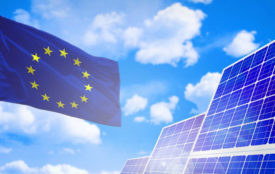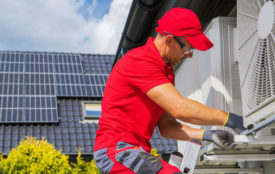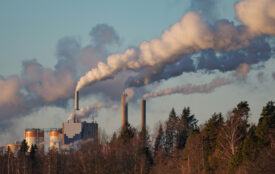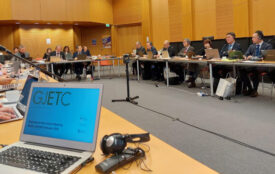Rebound in clean energy investment in 2014 beats expectations
Surges in investment in offshore wind in Europe, and solar in China and the US, helped to drive the 2014 global clean energy total up 16% to $310bn
World clean energy investment rebounded strongly in 2014, boosted by demand for large-scale and rooftop solar photovoltaics on the back of its greatly improved competitiveness, and by the financing of a record $19.4bn of offshore wind projects.
Authoritative annual data, published today by Bloomberg New Energy Finance, show that global investment in clean energy was $310bn last year. This was up 16% from a revised $268.1bn in 2013, and more than five times the figure of $60.2bn attained a decade earlier, in 2004, albeit still 2% below the all-time record of $317.5bn reached in 2011 .
The jump in investment in 2014 reflected strong performances in many of the main centres for clean energy deployment, with China up 32% to a record $89.5bn, the US up 8% to $51.8bn (its highest figure since 2012), Japan up 12% to $41.3bn, Canada up 26% at $9bn, Brazil up 88% at $7.9bn, India up 14% to $7.9bn, and South Africa up 5% at $5.5bn. Europe, despite the flurry in offshore wind, was a relative dull spot overall, investment there edging 1% higher to $66bn.
Michael Liebreich, chairman of the advisory board for Bloomberg New Energy Finance, said: “Throughout last year, we were predicting that global investment would bounce back at least 10% in 2014, but these figures have exceeded our expectations. Solar was the biggest single contributor, thanks to the huge improvements in its cost-competitiveness over the last five years.
“Healthy investment in clean energy may surprise some commentators, who have been predicting trouble for renewables as a result of the oil price collapse since last summer. Our answer is that 2014 was too early to see any noticeable effect on investment, and anyway the impact of cheaper crude will be felt much more in road transport than in electricity generation.”
Looking at the different categories of investment last year, asset finance of renewable energy projects was by far the largest, at $170.7bn, some 10% higher than in 2013. There were no fewer than seven European billion-dollar offshore wind projects reaching the “final investment decision” stage, including the $3.8bn, 600MW Gemini array off the Netherlands (the largest non-hydro renewable energy project on record in terms of dollars committed), the $2.6bn, 402MW Dudgeon project in UK waters, and the $1.7bn, 350MW Wikinger undertaking in the German area of the Baltic Sea.
Many big solar and onshore wind projects around the world were also financed in 2014. They included the Setouchi Mega PV project in Japan, at an estimated $1.1bn for 250MW, the Xina Solar One solar thermal plant in South Africa, at $1bn for 100MW, the $859m, 310.5MW Lake Turkana wind project in Kenya and the K2 wind complex in Ontario, Canada, at $728m and 270MW.
The second-largest category of investment was small distributed capacity – projects of less than 1MW, predominantly rooftop solar. This saw $73.5bn committed in 2014, up 34%. Research and development by governments and corporations totalled $29bn, some 2% more than in 2013, while asset finance of energy smart technologies such as smart meters came in at $16.8bn, up 8% on 2013.
New equity raised for clean energy companies on public markets hit a seven-year high in 2014, at $18.7bn, up 52% on the year. US electric car maker Tesla Motors raised $2.3bn via convertible issues, and a succession of US- and UK-listed “yieldcos” and project funds tapped investors for $3.9bn in total.
Venture capital and private equity investment in clean energy was $4.8bn in 2014, up 16% on the year but still far below the $12.3bn record set in 2008. The largest VC/PE deals last year were a $250m expansion round for US lithium-ion battery firm Boston-Power, a $250m expansion round for US solar installer Sunnova Energy, and a $150m late-stage VC round for US residential solar financier Sunrun.
The increased total for public market and VC/PE investment came despite a 3% slippage in clean energy share prices over the year. The WilderHill New Energy Global Innovation Index, or NEX, which tracks the just over 100 stocks worldwide, peaked at 220.58 in March 2014 and slid to 178.66 by year-end.
Solar made up almost half of total clean energy investment in 2014, its highest share ever. Last year, solar saw $149.6bn committed, up 25% on 2013. Investment in wind rose 11% to a record $99.5bn. The third largest sector was energy smart technologies, including smart grid, power storage, efficiency and electrified transport, with $37.1bn of investment, up 10%. Investment in biofuels was just $5.1bn in 2014, down 7%, and in biomass and waste-to-energy $8.4bn, down 10%. Geothermal attracted $2.7bn, up 23% on 2013, while small hydro-electric (projects of less than 50MW) got $4.5bn, down 17%.
The US investment total of $51.8bn in 2014 included $15.5bn of utility-scale asset finance, with wind down more than half at $5.9bn, hit by uncertainty over the future of its key incentive, the Production Tax Credit, and solar up 39% at $8.9bn. There was also $12.9bn of investment in small-scale projects. The Chinese total of $89.5bn included $73bn of asset finance, with both wind ($38.3bn) and solar ($30.4bn) up by more than 20%. China saw $7.6bn of spending on small distributed capacity.
Among European countries, overall investment rose 3% in the UK to $15.2bn and 3% in Germany to $15.3bn, while France jumped 26% to $7bn thanks partly to the financing of Europe’s biggest ever PV plant, the 300MW Cestas project. Big offshore wind deals drove the figure for the Netherlands up 232% to $6.7bn, but investment in Italy fell 60% to $2bn, hit by retroactive cuts in tariff support for PV plants.
In Australia, clean energy investment tumbled 35% to $3.7bn, the lowest since 2009, as wind and solar project developers delayed decisions while they awaited the government’s response to its Renewable Energy Target review.
Separate from the clean energy investment figures, Bloomberg New Energy Finance also released annual data today on “green bonds” – fixed-interest securities linked to clean energy and energy efficiency, and also other sustainability goals. Green bond issuance enjoyed another record year in 2014, with $38bn sold, two and a half times the 2013 total of $15bn. Volume was driven by a doubling in issuance from institutions like the World Bank and a five-fold increase in issuance from corporations.








